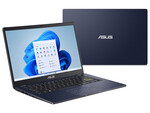Asus Vivobook Go 14X E410MA-EB1272WS
Ausstattung / Datenblatt

Preisvergleich
Durchschnitt von 1 Bewertungen (aus 3 Tests)
Testberichte für das Asus Vivobook Go 14X E410MA-EB1272WS
Quelle: Techrush.de

Eigentlich ist das ASUS Vivobook Go 14X ein solides Einsteiger-Notebook für unterwegs. Es ist kompakt, liegt gut in der Hand und sieht obendrein ganz hübsch aus.
Einzeltest, online verfügbar, Lang, Datum: 14.07.2022
Ausländische Testberichte
Quelle: 91mobiles
 EN→DE
EN→DEThe ASUS Vivobook Go 14 is a competent, budget-friendly laptop that caters to users with basic computing needs. It excels in providing essential functionality at an extremely competitive price point, making it an attractive option for consumers seeking a secondary device, or anyone operating on a tight budget. Apart from that, the combination of a decent build quality, a comfortable keyboard, and sufficient port selection makes it a practical choice for everyday use. However, those who can stretch their budget might find better performance in slightly higher-priced alternatives with more powerful processors. It’s important to weigh the pros and cons based on your specific needs. If you require a laptop for basic tasks such as web browsing, document editing, and media consumption, the Vivobook Go 14 is an excellent choice. However, for more demanding applications, investing in a higher-end model might be worthwhile.
Einzeltest, online verfügbar, Mittel, Datum: 30.07.2024
Bewertung: Gesamt: 70%
Quelle: Laptop Media
 EN→DE
EN→DEFrom its plastic shell to its poor performance, and not very good battery life. The ASUS E410 is a laptop that is built on the promises of compromises. You get this, but we take away that. This is where a bigger question comes in – do you really need a laptop? Are you willing to sacrifice your sanity to use the E410? Well, we are joking (of course). But really, if you want to remain intact, go for the Pentium iterations. Windows 11 really sucks on two cores. ASUS E410’s TN panel has a Full HD resolution. Its backlight doesn’t use PWM, while the pixel response times are really fast. On the other hand, the screen has very narrow viewing angles, a low contrast ratio, and limited color coverage (53% of sRGB). This makes the overall viewing experience pretty poor. This leads us to the other options – a 768p TN unit, which should be banned with a decree by the Pope, and a 1080p IPS panel. The latter is the choice you want to make, regardless of the price. Thankfully, ASUS has given you one M.2 PCIe lot to play with. We are not sure if the slot will persist, should you get an eMMC flash storage upon purchase. However, it is still good to see one. Plus, it supports NVMe drives! Expectedly, the port selection is not great – you lack an SD card slot, and one of the USB Type-As is 2.0. However, we’ve seen worse. So, would we recommend this product? Well, no. We wouldn’t. But honestly, there is nothing in this class that we would rather push you towards. Instead, if you really don’t have the budget for something better, make sure you get two things – a Pentium CPU, and an IPS panel. The other stuff is not that bad.
Einzeltest, online verfügbar, Sehr Lang, Datum: 12.04.2023
Kommentar
Intel UHD Graphics (Jasper Lake 16 EU): Integrierte Grafikkarte (in Jasper Lake Pentium Silver SoCs) der Gen. 11 Architektur mit 16 der 32 EUs (Shader-Cluster). Taktet mit 350 MHz Basistakt und bis zu 800 MHz Boost. Der Chip wird im 10nm Verfahren bei Intel gefertigt.
Einige nicht anspruchsvolle aktuelle Spiele können mit geringen Details noch flüssig gespielt werden. Für Office und Video natürlich ausreichende Leistungsreserven.
» Weitere Informationen gibt es in unserem Notebook-Grafikkartenvergleich und der Benchmarkliste.
Celeron N4500: Sparsamer Dual-Core-SoC aus der Jasper-Lake-Serie für preiswerte Notebooks. Taktet mit 1,1 bis 2,8 GHz und integriert eine DirectX-12-fähige Grafikeinheit mit 16 Kernen und max. 750 MHz Taktrate. Im Vergleich zu der Core-Serie (Ice Lake) mit langsameren CPU Kernen ausgestattet aber im selben 10nm Prozess bei Intel gefertigt.» Weitere Infos gibt es in unserem Prozessorvergleich Vergleich mobiler Prozessoren und der Prozessoren Benchmarkliste .

